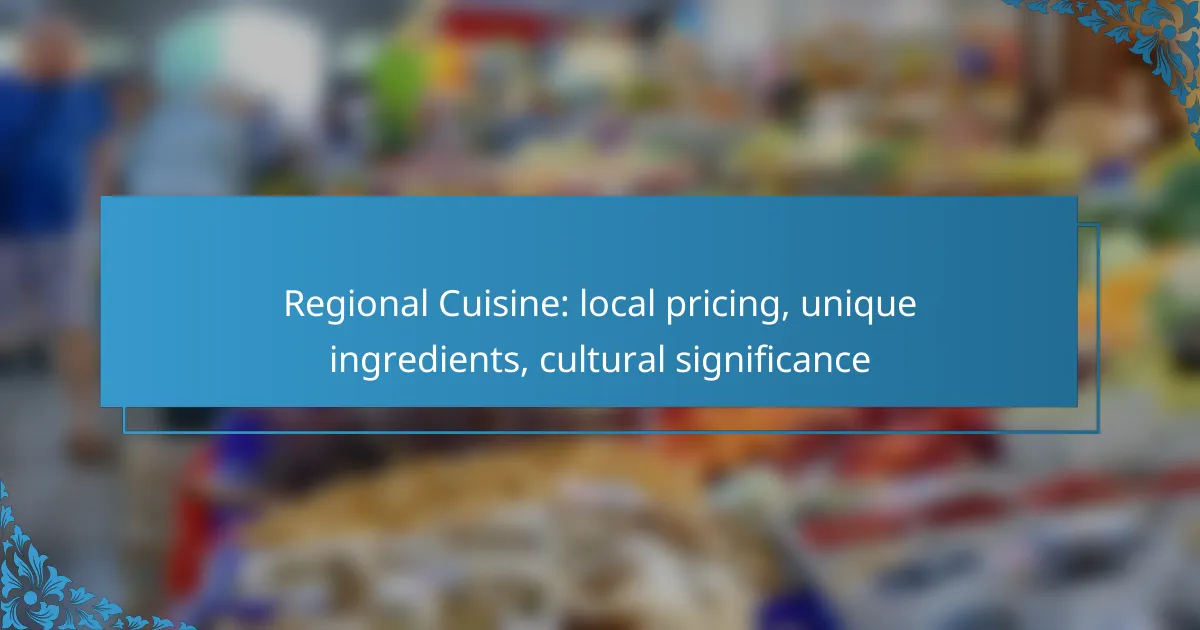Regional cuisine offers a rich tapestry of flavors and traditions, deeply rooted in local ingredients and cultural practices. By exploring unique ingredients and their significance, diners can gain insight into the culinary identity of a region, while understanding local pricing trends helps to navigate the diverse culinary landscape. This exploration not only satisfies the palate but also fosters a connection to the community and its history.

What are the local pricing trends for regional cuisine?
Local pricing trends for regional cuisine vary significantly based on location, ingredients, and cultural factors. Understanding these trends can help diners budget appropriately and appreciate the culinary landscape of each area.
Average meal costs in Los Angeles
In Los Angeles, the average cost of a meal at a mid-range restaurant typically ranges from $15 to $35 per person. This price can fluctuate based on the neighborhood, with areas like Santa Monica and West Hollywood generally being more expensive.
For a budget-friendly option, street food and casual dining can offer meals for around $10 to $15. Popular items include tacos, ramen, and poke bowls, reflecting the city’s diverse culinary influences.
Price variations in New Orleans
New Orleans showcases a wide range of meal prices, with average costs at restaurants falling between $20 and $50 per person. Iconic dishes like gumbo and jambalaya can be found at various price points, from casual eateries to upscale dining experiences.
Many local establishments offer lunch specials or happy hour deals, allowing diners to enjoy traditional cuisine at lower prices, often around $10 to $15. Exploring local markets can also yield affordable options for sampling regional flavors.
Factors affecting pricing in Chicago
In Chicago, several factors influence the pricing of regional cuisine, including ingredient availability, restaurant location, and the type of dining experience. Meals at casual restaurants typically range from $12 to $25, while fine dining can exceed $50 per person.
Seasonal ingredients and local sourcing can impact costs, as can the popularity of certain dishes. Diners should consider visiting during off-peak hours or seeking out food trucks for more budget-friendly options without sacrificing quality.

What unique ingredients define regional cuisines?
Unique ingredients are the backbone of regional cuisines, shaping flavors and culinary traditions. These ingredients often reflect local agriculture, climate, and cultural practices, making each cuisine distinct and significant.
Signature spices in Indian cuisine
Indian cuisine is renowned for its vibrant and diverse spices, which are essential for creating its rich flavors. Common spices include cumin, coriander, turmeric, and cardamom, each contributing unique aromas and tastes. The use of these spices not only enhances dishes but also carries cultural significance, often linked to traditional medicine and rituals.
When cooking Indian dishes, consider using whole spices for a fresher flavor. Toasting them briefly before grinding can elevate their taste, making your meals more authentic. A well-stocked Indian spice pantry typically costs between $20 to $50, depending on the variety and quality of spices purchased.
Local seafood in coastal New England
Coastal New England is famous for its fresh seafood, particularly lobster, clams, and scallops. These ingredients are not only staples in local dishes but also play a crucial role in the region’s economy and culture. Lobster rolls and clam chowder are iconic dishes that showcase the area’s seafood bounty.
When purchasing seafood, look for local markets that offer fresh catches. Prices can vary significantly, with lobster often ranging from $10 to $20 per pound, depending on the season and availability. Supporting local fishermen helps sustain the community and ensures the freshest ingredients for your meals.
Herbs used in Mediterranean dishes
Herbs are fundamental to Mediterranean cuisine, adding freshness and depth to a variety of dishes. Common herbs include basil, oregano, thyme, and rosemary, each contributing distinct flavors that enhance everything from salads to grilled meats. These herbs are often used fresh, reflecting the region’s emphasis on seasonal and local ingredients.
To incorporate Mediterranean herbs into your cooking, consider growing them in your garden or purchasing them from local farmers’ markets. Fresh herbs can elevate your dishes significantly, and a small herb garden can be started for under $30. Aim to use herbs generously, as they not only enhance flavor but also provide health benefits.

How does regional cuisine reflect cultural significance?
Regional cuisine serves as a mirror of cultural identity, showcasing local ingredients, cooking methods, and traditions that have been passed down through generations. These culinary practices not only nourish communities but also strengthen social bonds and preserve history.
Food traditions in Mexican culture
Mexican cuisine is rich with traditions that highlight the country’s diverse cultural heritage. Staples like corn, beans, and chili peppers are foundational, often prepared in ways that reflect regional customs. For instance, the use of masa to make tortillas is a practice that varies from one region to another, showcasing local preferences and techniques.
Celebrations often feature traditional dishes such as tamales and mole, which are not just meals but symbols of community and family gatherings. These foods are prepared with care and often involve the participation of multiple generations, reinforcing cultural ties.
Celebratory dishes in Southern cuisine
Southern cuisine is characterized by its celebratory dishes that often mark significant events and gatherings. Foods like gumbo, jambalaya, and fried chicken are staples at family reunions and holidays, reflecting the region’s rich agricultural history and cultural influences.
These dishes often incorporate local ingredients such as okra, rice, and various spices, which contribute to their unique flavors. The communal aspect of preparing and sharing these meals fosters a sense of belonging and continuity within Southern communities.
Influence of immigration on American regional foods
Immigration has profoundly shaped American regional cuisines, introducing diverse ingredients and cooking styles. Each wave of immigrants has contributed unique flavors, from Italian pasta dishes in the Northeast to Asian influences in West Coast cuisine.
This blending of culinary traditions creates a vibrant food landscape where regional dishes evolve. For example, the popularity of tacos in the United States reflects the integration of Mexican culinary practices, while also adapting to local tastes and available ingredients.

What are the best practices for sourcing local ingredients?
Sourcing local ingredients involves understanding your region’s agricultural landscape and building relationships with local producers. Prioritize freshness, seasonal availability, and sustainability to enhance the quality of your dishes while supporting the local economy.
Farmers’ markets in San Francisco
Farmers’ markets in San Francisco offer a vibrant selection of fresh produce, meats, and artisanal products. These markets typically operate on weekends, featuring local vendors who provide seasonal items directly to consumers. Prices can vary, but expect to pay slightly more than grocery stores for the quality and freshness.
When visiting, consider bringing reusable bags and cash, as some vendors may not accept cards. Look for organic certifications and ask vendors about their farming practices to ensure you’re making informed choices.
Community-supported agriculture in Portland
Community-supported agriculture (CSA) in Portland allows consumers to buy shares in local farms, receiving a weekly box of fresh produce. This model fosters a direct connection between consumers and farmers, promoting seasonal eating and reducing food miles. Share prices typically range from $20 to $50 per week, depending on the farm and share size.
Joining a CSA can enhance your cooking by introducing you to unique, local ingredients. Be prepared to adapt your meal planning based on what’s in season, and communicate with your farm for tips on storage and preparation of unfamiliar items.

How can restaurants highlight regional cuisine?
Restaurants can effectively highlight regional cuisine by showcasing local ingredients and traditional cooking methods. This approach not only enhances the dining experience but also connects patrons with the cultural significance of the dishes.
Menu design strategies for local dishes
To emphasize local dishes, restaurants should design menus that feature seasonal ingredients and highlight their origins. Descriptive language can evoke the cultural context, making each dish more appealing. For instance, instead of simply listing “grilled fish,” a menu might read “locally sourced grilled trout with herb-infused butter.”
Incorporating visuals, such as photographs of the dishes or the local farms where ingredients are sourced, can further engage customers. Additionally, consider using a separate section for regional specialties to draw attention to these offerings.
Marketing regional specialties in Atlanta
In Atlanta, restaurants can market regional specialties by leveraging local food festivals and community events. Collaborating with local farmers and producers for special events can create buzz and attract food enthusiasts. Highlighting these partnerships on social media can also enhance visibility.
Offering tasting menus that feature a variety of regional dishes allows customers to experience the diversity of local cuisine. Pricing should reflect the quality of ingredients, typically ranging from $15 to $50 per person for a multi-course experience, depending on the restaurant’s positioning.

What are the emerging trends in regional cuisine?
Emerging trends in regional cuisine reflect a growing interest in diverse flavors, sustainability, and health. Chefs and home cooks alike are increasingly blending traditional dishes with modern techniques and ingredients, while also prioritizing local sourcing and nutritional value.
Fusion cuisine in urban areas
Fusion cuisine is becoming increasingly popular in urban areas, where diverse populations bring various culinary traditions together. This trend often results in innovative dishes that combine elements from different cultures, such as Korean tacos or sushi burritos.
Restaurants in cities like New York and Los Angeles frequently experiment with fusion concepts, attracting food enthusiasts eager to try unique flavor combinations. These dishes often reflect the local demographic, showcasing ingredients and techniques from the community.
Sustainable practices in local food sourcing
Sustainable practices in local food sourcing are gaining traction as consumers become more environmentally conscious. Many restaurants are now prioritizing ingredients from local farms, reducing transportation emissions and supporting regional economies.
Chefs often collaborate with local producers to create seasonal menus that highlight fresh, regional ingredients. This not only enhances the flavor of dishes but also fosters a connection between diners and the source of their food.
Health-conscious adaptations of traditional recipes
Health-conscious adaptations of traditional recipes are on the rise as more people seek nutritious options without sacrificing flavor. Chefs are reimagining classic dishes by substituting ingredients to reduce calories, fats, or sugars while maintaining authenticity.
For instance, using whole grains instead of refined flour or incorporating more vegetables into traditional recipes can enhance nutritional value. This trend allows diners to enjoy familiar flavors while adhering to healthier eating habits.
